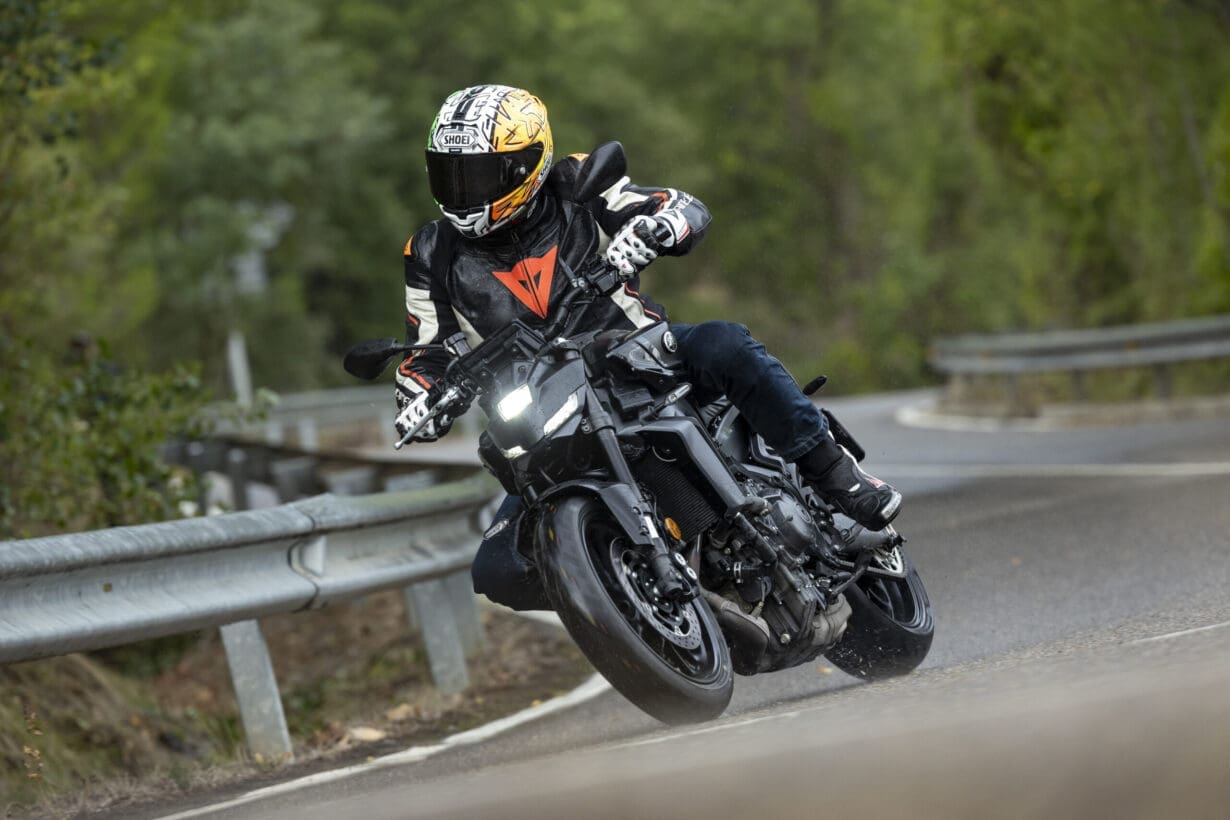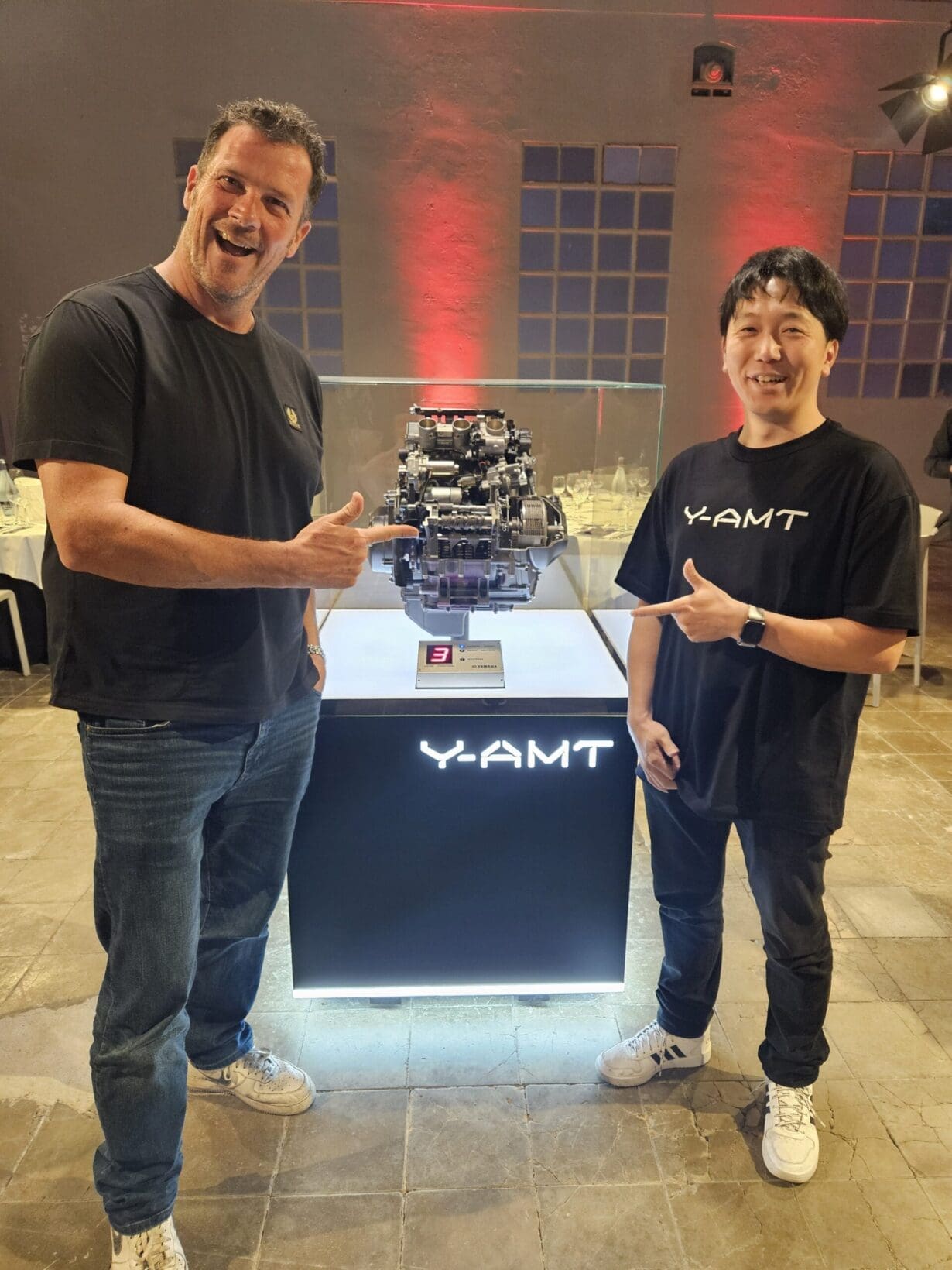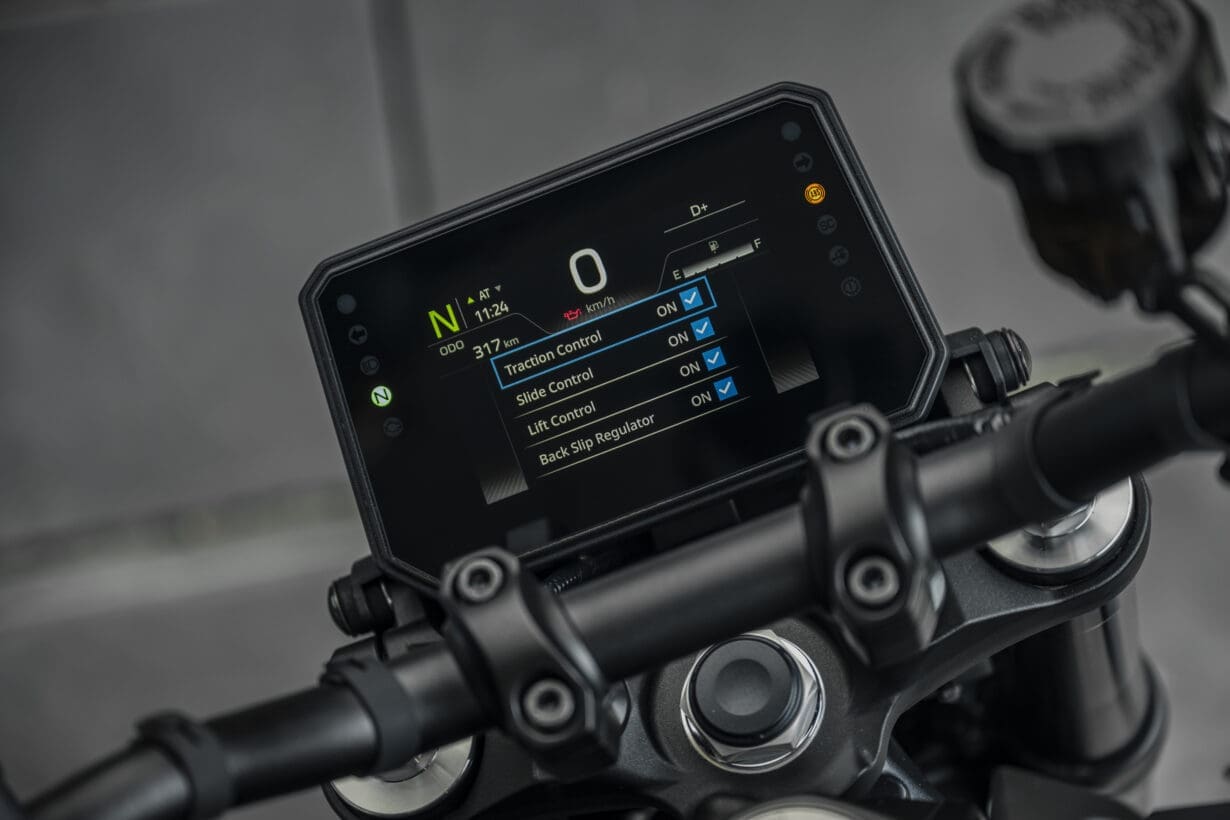Bikes with auto gearboxes seem to be the ‘in thing’ right now, with recent additions to the market coming from BMW, KTM, Honda and, now, Yamaha. John McAvoy gave the latter brand’s new, fancy Y-AMT system a spin to see whether it’s the gamechanger we’re looking for.
This isn’t the first time that Yamaha have dabbled with gearboxes that are operated by hand. They dipped their toe into the concept back in 2006 with the FJR1300 YCCS, which was a pretty agricultural hydraulic system, even by the standards of the day. However, it did signal intent by Yamaha that there was some merit to be had by pushing a button instead of actuating a crude, lever long enough to accommodate a booted foot underneath it. The FJR1300 YCCS came and went in the blink of an eye, and being blunt, it was never missed.
Fast forward nearly 20 years, and thanks entirely to the fact that bikes are now all ride-by-wire – something Yamaha were the first to put into production – and with seemingly all the electronic rider aids known to man having been invented and implemented on to just about every quality motorcycle, Yamaha have decided to revisit the clutchless gearbox again, but this time from a different angle. Now with the benefit of quickshifters and ECUs which feed off information about literally every aspect of the motorbike AND which in turn makes decisions with that information, the clutchless gearbox now has a whole new set of tech available today than what it did back in 2006. Think of the new Y-AMT (Yamaha – Automated Manual Transmission) system doing to gearboxes and clutches what ride-by-wire did to throttle bodies. It’s still a mechanical movement, but electrically controlled based on data provided by the bike’s main ECU about what the bike is doing at any given moment.

The genius of how the system works is its simplicity. It literally uses the exact same clutch and gearbox as the MT-09, but has one electric motor/solenoid that via a very simple mechanical lever set up actuates the clutch, and another which rotates the gearbox selector drum depending on whether it’s an upshift or downshift. There is literally no difference between the two engines and engine cases because the Y-AMT system retro fits to the engine, and can be retro fitted to any current Yamaha engine.
The system has its own control unit (an MCU) which, in automatic mode, controls the two solenoids based on revs, throttle position, speed and gear position to decide what sort of gearshift you’re going to get – up or down – if any at all, and when you’re going to get it. In manual mode, the system does whatever you tell it to, when you tell it.
When I pressed the Y-AMT designer, Tamemasa Tukuma, if we’re likely to see the system on a sportsbike, all I could get from him was that it fits directly to their CP-2 and CP-3 engines as it is, so expect to see it at some point down the line as an option on any of Yamaha’s bikes with those engines, but whether or not it’ll appear on a sportsbike remains to be seen. Having said that, I must admit to being a bit surprised that of all the bikes in their range Yamaha chose to debut the system on, they chose to do away with the clutch on the one bike which arguably benefits from having a clutch the most.
The MT-09 is such a brilliant bike, and it’s great for a lot of reasons, not least how easy it is to wheelie with a whiff of clutch in just about any gear. Granted, wheelies aren’t for everyone, but if indulging in the odd spontaneous, impromptu bit of tomfoolery is, not having a clutch lever to make the process smooth and easy is a problem.

The MT-09 Y-AMT works out at £550 dearer than the regular MT-09, which is the only one that the system is optional on – in all colours – but not the MT-09SP, so the question is, is it worth it? Well, typically there isn’t a straight answer to that question, but I was one of the lucky ones with a seat on the plane to Barcelona for a 350km ride into the Pre-Pyrenees region of Spain on one to find out.
As the name suggests, there’re two modes that the system can work in: Automatic (which you can actually override manually), or fully manual, which won’t do anything unless you tell it to. I started out in automatic mode, because the absence of a clutch lever and gear lever were already messing with my brain too much to also have to deal with pushing buttons to change gear as well. I preferred to go softly-softly to begin with, and all I had to do was engage first gear by pushing a button, then forget about it. Pressing the button produces the familiar mechanical sound of a bike clunking into first gear, which was a bit odd because my left foot hadn’t done it.
We headed out and got into the ride, which started with some motorway miles which revealed the first sign that this automatic gearbox is nothing like any other automatic gearbox before. Of course, strictly speaking it’s not automatic, it’s a completely normal manual gearbox that’s just being controlled by motors instead of me.
If you’re cruising along at a constant speed and crack the throttle open for a quick burst of acceleration, there’s no delay waiting for the gearbox to ‘kickdown’. Instead, by the time the throttle reaches the stop, it’s already shifted down a gear, and the acceleration is piling on. It’s seriously impressive and is down to lots of factors of course – principally all the information going to the MCU from the bike’s ECU – but also the fact that integrated in the system is Yamaha’s latest quickshifter, which will downshift on an open throttle. As the gearbox swops cogs, it does so with a reassuringly familiar and positive clunk that makes an entirely digitally controlled process feel surprisingly analogue. It’s brilliant.
When the road started getting twisty, and the pace increased, I was really impressed how it was swopping gears at virtually the exact same moment I thought, ‘A backshift would be good right now’ or ‘I could do with a shortshift here’ or ‘I really hope it doesn’t shift at all here, and just lets me hang on to the revs to my next braking marker’. I’d say that after about 50km of fairly high tempo riding on mountain passes, it probably did a shift that I wasn’t expecting, or didn’t want maybe just three or four times.
What’s really impressive about it in automatic mode, is how unlike normal/actual automatic gearboxes, when you’re braking, it doesn’t wait until you pick the throttle back up in the corner to do it’s downshifting, the Y-AMT system downshifts when you’re braking, so when you get into the corner, you’re at the right revs and gear ready to get back on the gas. The gear pattern and timing of shifts is very natural.
Time to up the ante by putting the MT-09 in sport mode, and the Y-AMT into manual mode. I’m genuinely nervous at first, because I’m worried that there’s so much muscle memory in my brain and body that I just won’t be able to adapt to it. It’s true that at first I couldn’t remember which way to push the button for up or down, or even where the button was, but just like adapting to a bike which has its gear lever set to the race shift pattern, after a while you just start doing it, and it seems natural. Even though it didn’t take long at all to get comfortable with the whole idea of not using my left hand and foot to shift gear, it was always in the back of my mind that what if something unexpected happened and I needed to rely on reflex?
One-hundred-and-fifty kilometres in, and considering we were a group of eight people from the UK motorcycle press, and we were riding MT-09s, universally recognised as one of the most wheelie-able bikes in the world, the lack of one-wheel antics was notable by their absence. There were plenty of attempts using brute force, which mostly just fizzled out before reaching the precious balance point, but nothing like what would have been the case if they were ‘normal’ MT-09s.
The truth is, there are only two ways you can wheelie an MT-09 Y-AMT. One of them is with the assistance of a crest, and the other is to use first gear quite aggressively and stab the + button to get second gear engaged just as the front wheel approaches the balance point, and you’re away. So, you’re basically limited to those two scenarios for some naughtiness, whereas on the normal MT-09, you can flick the clutch lever at any time in the first three gears, which covers just about every corner you’ll ever come across anywhere in the world.
Why am I going on about wheelieing so much? Well, there’re two reasons. One is that we’ve already covered the latest 2024 MT-09 and MT-09SP in the mag, so I don’t want to use up valuable page space on regurgitating what we’ve already said about the bike, and I want to focus on the only thing that is different with this one, which is the gearshift, and how if at all it changes the bike’s dynamics which we already know, and being a lot less accommodating at one of its party tricks is worthy of note. The second reason is that it matters, because for some people wheelies are a big part of why they enjoy riding bikes, and while with the Y-AMT they can be done, the circumstances in which they can be done are limited so much so, that I’d have to say for anyone who gets their kicks that way, the Y-MAT probably isn’t for you.
However, with the grey area of wheelies dealt with, and concentrating on just the riding experience, the Y-AMT system is a little gem. It’s seriously impressive how it brings together all the bike’s engine braking strategies, blipper, and now a pair of solenoids to operate the clutch and gearbox’s shift drum is brilliant. It’s so fast at back-shifting that it’s like a video game, and if a third gear corner unexpectedly turns into a second gear corner when you’re already leant over, as it did on me a few times during the day, just stab the
‘–‘ button with your thumb, and like that you’re in the right gear, and the extra revs are pulling you up mid-corner without overloading the front tyre.

I got separated from the group at one point, and for about the next 10km I went into full ‘beast’ mode to catch them back up. I was fully focused on where I was braking and how much I was going to commit to each corner depending on how far I could see through it, and how early and how hard I could get on the throttle. I completely stopped thinking about using the buttons to shift gear and was just doing it. I don’t honestly think I would have been able to ride any quicker using my foot to shift gear with a quickshifter/blipper.
Yamaha claim that the Y-AMT system swops the cogs in 0.1 seconds, which is the same as a quickshifter/blipper set up, and while that might be the case, I felt like the Y-AMT shift was much more direct and positive than a quickshifter/blipper which can – depending on the system – feel a bit lazy and digital. With the Y-AMT, you can feel the cogs swopping via a jolt through the chassis; it’s a much more mechanical sensation which I much prefer to a shifter/blipper set up.
So, back to my original question, is it any good? Yes, as a piece of new technology it is extremely clever, and very innovative how it works by using what’s already there. The system adds 2.8kg to the bike’s weight, which is probably why you won’t see it on a hardcore sportsbike for a while, if ever. On something where weight is less of an issue, I expect the Y-AMT system will start popping up, and the case for it is strong.
It’s not without its shortcomings though. You can’t bump start a bike which has a Y-AMT system fitted, so if you get a flat battery on one, a push down the street to get it started isn’t an option, you’ll need a jump-pack, or to charge your battery before you go anywhere. Also, if it fails when you’re in a gear, to get it into neutral you have to remove a side cover and fiddle about with a lever, which is not ideal. Better to just fit a clutch lever, which is entirely possible since the engine, clutch and gearbox are identical to the MT-09, but Yamaha say no. Also, on more than one occasion the material on the tip of the thumb of my glove would catch the ‘– ‘button, and actuate a downshift, so there’s some work to be done on either the sensitivity of the button(s) or their location, or both.
As a piece of technology, Y-AMT is simply brilliant how it delivers in both automatic and manual mode. It’s taken the whole ride-by-wire technology and applied it to a new element of the riding experience. It works, it really does, but has it revolutionised the process of shifting gear? I’m not sure, but then realistically, I’m not the target customer for a Y-AMT bike. Yamaha are quite open that they’re aiming this at a much, much younger generation of riders, and furthermore riders who are more interested in touring or adventuring than me, and in those scenarios, the Y-AMT system could be transformative, just not for me.


